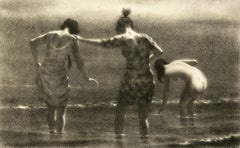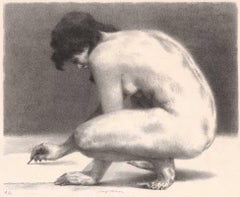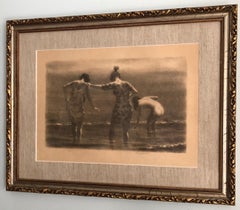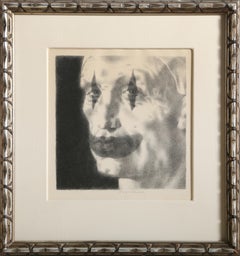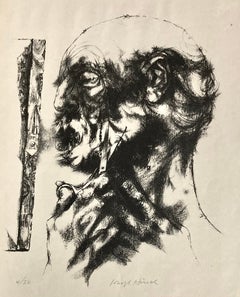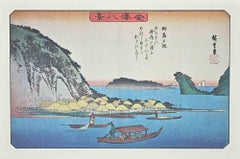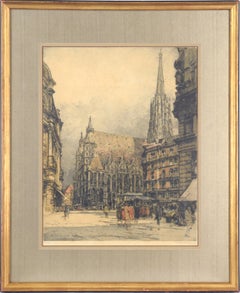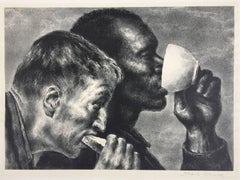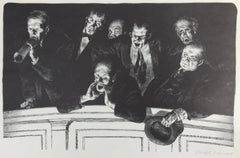Joseph Hirsch Prints and Multiples
American, 1910-1981
Joseph Hirsch was a member of the American Academy-Institute of Arts and Letters and a well-known realistic artist who came to national attention as a muralist for the Federal Works Progress Administration in the 1930's.
Of his own work, Mr. Hirsch wrote: ''I believe that some day the fabric of art will be threaded with morality, enabling us to distinguish evil from good. Today, this is unthinkable, in the delightful art world where, excepting censorship, anything goes. But anything goes does not accord with the more discriminating ethics of our civilized code which rules out what is socially destructive.''
Mr. Hirsch is represented in the Metropolitan Museum of Art, the Museum of Modern Art and the Whitney in New York; the National Gallery, the Corcoran and the Hirshhorn in Washington; the Boston Museum of Fine Arts, and in many major collections in the United States.
Joseph Hirsch was born on April 25, 1910 in Philadelphia, Pennsylvania. Hirsch studied at the Philadelphia Museum School, with Henry Hensche in Provincetown, Mass., and with George Luks in New York. In addition to formal study,
He participated in the Works Project Administration in the easel painting division, with occasional work in the mural division, where he painted murals in the Amalgamated Clothing Workers Building and the Municipal Court. During World War II, Joseph Hirsch took part in the war effort, as an artist war correspondent, recording significant battles and events.
He taught at the Chicago Art Institute, the American Art School, University of Utah, and had a significant tenure at the Art Students League in New York. He also won many awards, among them were a fellowship at the American Academy in Rome, the Walter Lippincott Prize, First Prize at the New York World's Fair (1939), the Guggenheim Foundation Fellowship (1942, 1943), and the Fulbright Fellowship (1949). In 1954 he was elected into the National Academy of Design as an Associate member and became a full Academician in 1958
Early in his career, Hirsch was introduced to the movement of Social Realism through George Luks, who was one of "The Eight". This group of painters, at the beginning of the century, chose to depict ordinary and everyday scenes. From this movement stemmed the Social Realism genre of the 1920s and 1930s. Social commentary was the backbone for the majority of Joseph Hirsch's paintings.
During World War II, Mr. Hirsch went to the South Pacific, North Africa and Italy as an artist-correspondent for the Navy, and his paintings and drawings are in the Museum of Military History. . In Major Collections. Hirsch's work is represented in the Metropolitan Museum of Art, the Museum of Modern Art and the Whitney in New York; the National Gallery, the Corcoran and the Hirshhorn in Washington; the Boston Museum of Fine Arts, and other collections in the USA. He was elected to membership in the National Institute of Arts and Letters in 1967. Hirsch died in New York, NY on September 21, 1981.to
2
8
4
5
Overall Width
to
Overall Height
to
5
21
1,212
962
927
836
17
2
6
4
10
6
14
7
7
5
4
3
3
2
2
2
1
1
1
1
1
1
1
1
1
1
16
2
3
1
17
Artist: Joseph Hirsch
September Morn - In Celebration of Pride Month
By Joseph Hirsch
Located in New Orleans, LA
Stone and Press Gallery is excited to offer several works in celebration of the LGBTQ community.
Three women strolling on a beach. This impression is one of the rare impressions p...
Category
1960s American Modern Joseph Hirsch Prints and Multiples
Materials
Lithograph
$1,200 Sale Price
33% Off
Nude drawing (Nude on her haunches draws ) - In Celebration of Pride Month
By Joseph Hirsch
Located in New Orleans, LA
Stone and Press Gallery is excited to offer several works in celebration of the LGBTQ community.
A nude woman squats on her haunches as she draws an image on a sheet of paper. Jos...
Category
1960s American Modern Joseph Hirsch Prints and Multiples
Materials
Lithograph
original lithograph
By Joseph Hirsch
Located in Henderson, NV
Medium: original lithograph. This lithograph was printed in 1958 for the "Improvisations" portfolio, published by the Artists Equity Association of New York on the occasion of the 19...
Category
1950s Joseph Hirsch Prints and Multiples
Materials
Lithograph
Joseph Hirsch "September Morn" Rare Variant Signed / Numbered, circa 1960s
By Joseph Hirsch
Located in San Francisco, CA
Joseph Hirsch (1910-1981) "September Morn" rare variant signed / numbered, circa 1960s
"September Morn" is most recognized in its color variant. This is the much rarer non color var...
Category
Mid-20th Century Other Art Style Joseph Hirsch Prints and Multiples
Materials
Lithograph
Painted Man, American Realist Lithograph by Joseph Hirsch
By Joseph Hirsch
Located in Long Island City, NY
Joseph Hirsch, American (1901 - 1981) - Painted Man, Year: 1963, Medium: Lithograph, signed in pencil, Edition: 250, Image Size: 9.25 x 9 inches, Size: 14 x 13 in. (35.56 x 33.0...
Category
1960s American Realist Joseph Hirsch Prints and Multiples
Materials
Lithograph
Joseph Hirsch, (Cutting the Beard)
By Joseph Hirsch
Located in New York, NY
A man with lots of whiskers is trimming his facial hair while looking in a mirror. The male figure and his beard are carefully drawn but Hirsch has cleverly just briefly sketched in ...
Category
Mid-20th Century Ashcan School Joseph Hirsch Prints and Multiples
Materials
Lithograph
Joseph Hirsch, Beard
By Joseph Hirsch
Located in New York, NY
Joseph Hirsch had such empathy for his subjects! But he was also an amazingly skilled lithographer who could get extremely delicate details out of the stone. Signed and numbered in p...
Category
Mid-20th Century American Modern Joseph Hirsch Prints and Multiples
Materials
Lithograph
The Boston Tea Party, American Art Lithograph by Joseph Hirsch
By Joseph Hirsch
Located in Long Island City, NY
The Boston Tea Party by Joseph Hirsch, American (1901–1981)
Date: 1975
Offset Lithograph (unsigned as issued)
Size: 17 x 14 in. (43.18 x 35.56 cm)
Frame Size: 20 x 17 inches
An orig...
Category
1970s American Modern Joseph Hirsch Prints and Multiples
Materials
Lithograph
$360 Sale Price
20% Off
Man with Mask
By Joseph Hirsch
Located in Fairlawn, OH
Man with Mask
Lithograph, 1969
Signed in pencil by the artist
95/100
Printed by Lucien Detruit, Paris
Published by AAA, New York
Reference: AAA Index No. 60
Condition: Mint
Image siz...
Category
1960s American Modern Joseph Hirsch Prints and Multiples
Materials
Lithograph
Joseph Hirsch Original Lithograph Signed in Pencil - The Toast
By Joseph Hirsch
Located in Phoenix, AZ
Joseph Hirsch (1910-1981) Philadelphia/New York artist - Pencil signed lithograph
Title: The Toast. Signed lower right and numbered lower left 79 of 100.
The tondo work is 11 1/2 inc...
Category
1970s Joseph Hirsch Prints and Multiples
Materials
Paper, Lithograph
The Crucifixion, Realist Lithograph by Joseph Hirsch
By Joseph Hirsch
Located in Long Island City, NY
Artist: Joseph Hirsch, American (1901 - 1981)
Title: The Crucifixion
Year: circa 1979
Medium: Lithograph, Signed and Numbered in Pencil
Edition: 100
Si...
Category
1960s American Realist Joseph Hirsch Prints and Multiples
Materials
Lithograph
Artist's Hand, Framed Realist Lithograph by Joseph Hirsch
By Joseph Hirsch
Located in Long Island City, NY
Artist: Joseph Hirsch, American (1901 - 1981)
Title: Artist's Hand (Cole 51)
Year: 1966
Medium: Lithograph, signed and numbered in pencil
Edition: 30/200
Image Size: 19 x 15 inches
F...
Category
1960s American Realist Joseph Hirsch Prints and Multiples
Materials
Lithograph
UNTITLED (WOMAN WITH HANDS ACROSS BREASTS)
By Joseph Hirsch
Located in Portland, ME
Hirsch, Joseph. UNTITLED (WOMAN WITH HANDS ACROSS BREASTS). Lithograph in two colors, not dated, but between 1970/80. Not in Cole. Edition of 100. Signed and numbered 85/100 in penci...
Category
1970s Joseph Hirsch Prints and Multiples
Materials
Lithograph
MODEL AND EASEL
By Joseph Hirsch
Located in Portland, ME
Hirsch, Joseph. MODEL AND EASEL. Lithograph, 1952. Cole 25.
21 3/4 x 8 1/2 in.
Edition of 50 on Arches paper, printed by Gaston Dorfinant, Paris, using two inks.
Signed in pencil...
Category
Mid-20th Century Joseph Hirsch Prints and Multiples
Materials
Lithograph
MOTO
By Joseph Hirsch
Located in Portland, ME
Hirsch, Joseph. MOTO. Cole 20. Lithograph, 1950. 18 1/2 x 16 1/4 inches; 470 x 413 mm. Edition of 75, signed in pencil. Printed on Arches paper by Gaston Dorfinant, Paris. A fine imp...
Category
1950s Joseph Hirsch Prints and Multiples
Materials
Lithograph
$2,500
RUNNING WOMEN.
By Joseph Hirsch
Located in Portland, ME
Hirsch, Joseph. RUNNING WOMEN. Lithograph 1973. Not in Cole. 16 x 29 1/2 in. An Artist's Proof aside from the edition of 95, signed in pencil, inscribed ...
Category
1970s Joseph Hirsch Prints and Multiples
Materials
Lithograph
Joseph Hirsch Original Lithograph, Pencil Signed, 1961, "Coffee"
By Joseph Hirsch
Located in Phoenix, AZ
Joseph Hirsch (American, 1910-1981) original lithograph, pencil signed.
Title: Coffee. Edition size: 250. Catalog raisonne reference: Cole 38.
Image size: 13"H x 10"W.
Published by A...
Category
Mid-20th Century Joseph Hirsch Prints and Multiples
Materials
Paper
Related Items
Eight Scenic Spots in Kanazawa After Utagawa Hiroshige-Mid 20th Century
By Utagawa Hiroshige
Located in Roma, IT
Eight Scenic Spots in Kanazawa is a modern artwork realized in the Mid-20th Century.
Mixed colored lithograph after a woodcut realized by the great Japanese artist Utagawa Hiroshige...
Category
Mid-20th Century Modern Joseph Hirsch Prints and Multiples
Materials
Lithograph
$239
H 10.24 in W 14.97 in D 0.04 in
St. Stephen's Cathedral in Vienna - Hand Colored Cityscape Lithograph
By Luigi Kasimir
Located in Soquel, CA
Detailed and dramatic hand-colored etching by Luigi Kasimir (Austrian, 1881-1962). St. Stephen's cathedral towers above the streets of Vienna, with people going about their daily bus...
Category
1920s Photorealist Joseph Hirsch Prints and Multiples
Materials
Paper, Watercolor, Lithograph
$1,120 Sale Price
20% Off
H 29.75 in W 23.75 in D 0.75 in
Walking in Snowy Winter - Lithograph After Utagawa Hiroshige - Mid 20th Century
By Utagawa Hiroshige
Located in Roma, IT
Walking in Snowy Winter is a modern print realized in the Mid-20th Century.
Mixed colored lithograph after a woodcut realized by the great Japanese artist Utagawa Hiroshige in the 1...
Category
Mid-20th Century Modern Joseph Hirsch Prints and Multiples
Materials
Lithograph
$239
H 14.97 in W 10.24 in D 0.04 in
Original 'The U. S. Marines Want You' vintage military recruiting poster
Located in Spokane, WA
Original vintage poster: The U.S. Marines Want You. This military vintage poster is archival linen-backed and in fine condition, ready to frame. There is no date, artist, or printer'...
Category
1910s American Realist Joseph Hirsch Prints and Multiples
Materials
Lithograph
$2,250
H 28 in W 21.75 in D 0.05 in
Boatmen-Eight Scenic Spots Along Sumida River After U. Hiroshige-20th Century
By Utagawa Hiroshige
Located in Roma, IT
Boatmen - Eight Scenic Spots Along Sumida River is a modern print realized in the Mid-20th Century.
Mixed colored lithograph after a woodcut realized by the great Japanese artist Ut...
Category
Mid-20th Century Modern Joseph Hirsch Prints and Multiples
Materials
Lithograph
$239
H 10.24 in W 14.97 in D 0.04 in
Marc Chagall - Double Portrait - Original Lithograph
By Marc Chagall
Located in Collonge Bellerive, Geneve, CH
Marc Chagall, Original Lithograph depicting an instant of the Bible.
Technique: Original lithograph in colours
Year: 1956
Sizes: 35,5 x 26 cm / 14" x 10.2" (sheet)
Published by: Édit...
Category
1950s Modern Joseph Hirsch Prints and Multiples
Materials
Lithograph
$1,557
H 13.98 in W 10.24 in D 0.04 in
after Henri Matisse - Acrobat
By Henri Matisse
Located in Collonge Bellerive, Geneve, CH
after Henri Matisse - Acrobat
Edition of 200
with the printed signature, as issued
76 x 56
With stamp of the Succession Matisse
References : Artvalue - Succession Matisse
Category
1950s Modern Joseph Hirsch Prints and Multiples
Materials
Lithograph
The ORIGINAL limited edition 1965 Los Angeles County Museum of Art LACMA poster
By Alexander Calder
Located in New York, NY
Alexander Calder
The original Los Angeles County Museum of Art poster, 1965
Limited Edition vintage Offset Lithograph
32 × 24 3/4 inches 81.3 × 62.9 cm
Edition of 300
This is the OR...
Category
1960s Modern Joseph Hirsch Prints and Multiples
Materials
Lithograph, Offset
'Eyes for the Night' — Mid-century American Surrealism
By Benton Murdoch Spruance
Located in Myrtle Beach, SC
Benton Spruance, 'Eyes for the Night', lithograph, 1947, edition 35, Fine and Looney 260. Signed, dated, titled, and annotated 'Ed 35' in pencil. A fine impression, on heavy, cream ...
Category
1940s American Modern Joseph Hirsch Prints and Multiples
Materials
Lithograph
$720 Sale Price
20% Off
H 18.88 in W 12.88 in
The Jewish Welfare Board original 1918 vintage World War 1 antique poster
By Sidney Riesenberg
Located in Spokane, WA
The Jewish Welfare Board. Original World 1 vintage poster, very good condition; archival linen-backed and ready to frame. Printer: Alco-Gravure, Inc., N. Y. There is a tiny ch...
Category
1940s American Realist Joseph Hirsch Prints and Multiples
Materials
Lithograph
$899
H 32.75 in W 19.75 in D 0.01 in
Madman's Drum (Brothel) — 'Story Without Words' Graphic Modernism
By Lynd Ward
Located in Myrtle Beach, SC
Lynd Ward, 'Madman's Drum, Plate 41', wood engraving, 1930, edition small. Signed in pencil. A fine, richly-inked impression, on off-white tissue-thin Japan paper; the full sheet with margins (1 5/8 to 2 1/2 inches); a small paper blemish in the upper right margin, away from the image, otherwise in excellent condition. A scarce, artist-printed, hand-signed proof impression before the published edition. Matted to museum standards, unframed.
Image size 5 1/2 x 3 3/4 inches (140 x 95 mm); sheet size 9 5/8 x 7 1/8 inches (244 x 181 mm).
From Lynd Ward’s book of illustrations without words, 'Madman’s Drum', Jonathan Cape and Harrison Smith, New York, 1930.
Reproduced in 'Storyteller Without Words, the Wood Engravings of Lynd Ward', Harry N. Abrams, New York, 1974.
ABOUT THE ARTIST
Lynd Ward is acknowledged as one of America’s foremost wood engravers and book illustrators of the first half of the twentieth century. His innovative use of narrative printmaking as a stand-alone storytelling vehicle was uniquely successful in reaching a broad audience. The powerful psychological intensity of his work, celebrated for its dynamic design, technical precision, and compelling dramatic content, finds resonance in the literature of Poe, Melville, and Hawthorne. Like these classic American writers, Ward was concerned with the themes of man’s inner struggles and the role of the subconscious in determining his destiny. An artist of social conscience during the Great Depression and World War II, he infused his graphic images with his unique brand of social realism, deftly portraying the problems that challenged the ideals of American society.
The son of a Methodist preacher, Lynd Ward, moved from Chicago to Massachusetts at an early age. He graduated from the Teachers College of Columbia University, New York, in 1926, where he studied illustration and graphic arts. He married May Yonge McNeer in 1936 and left for Europe for their honeymoon in Eastern Europe. After four months, they settled in Leipzig, where Ward studied at the National Academy of Graphic Arts and Bookmaking. Inspired by Belgian expressionist artist Frans Masereel's graphic novel ‘The Sun,’ and another graphic novel by the German artist Otto Nückel, ‘Destiny,’ he determined to create his own "wordless" novel. Upon his return to America, Ward completed his first book, ‘God's Man: A Novel in Woodcuts,’ published in 1929. ‘Gods’ Man’ was a great success for its author and publisher and was reprinted four times in 1930, including a British edition. This book and several which followed it, ‘Madman’s Drum,’ 1930, ‘Wild Pilgrimage...
Category
1930s American Modern Joseph Hirsch Prints and Multiples
Materials
Woodcut
$650
H 5.07 in W 3 in D 0.01 in
Norman Rockwell Framed Lithograph Willie takes a step - 1971.
By Norman Rockwell
Located in Pembroke Pines, FL
Artist: Norman Rockwell
Title: Willie Takes a Step
Year: 1971
Dimensions: 18 x 24 Inches.
Framed Approx.: 24 x 30 Inches.
Edition: 69/200
Medium: Lithograph
Condition: Excellent
Sig...
Category
1970s Contemporary Joseph Hirsch Prints and Multiples
Materials
Lithograph
$3,250
H 30 in W 24 in D 1 in
Previously Available Items
BANQUET
By Joseph Hirsch
Located in Santa Monica, CA
JOSEPH HIRSCH (1919 - 1981)
BANQUET 1945 (Cole 11)
Lithograph, 9 3/4 x 13 3/4 inches. Signed in pencil.. Edition 250 as published by Associated American Artists. Full margins with...
Category
1940s American Realist Joseph Hirsch Prints and Multiples
Materials
Lithograph
THE HECKLERS
By Joseph Hirsch
Located in Santa Monica, CA
JOSEPH HIRSCH (American 1910 - 1981)
THE HECKLERS 1943-4
Lithograph as published by Associated American Artists (AAA). Edition c. 250. 9 3/4 x 15 1/4 Inches. Signed in pencil. Full ...
Category
1940s Realist Joseph Hirsch Prints and Multiples
Materials
Lithograph
20th century lithograph black and white stylistic figurative print signed
By Joseph Hirsch
Located in Milwaukee, WI
"Man with Scales" is an original lithograph by Joseph Hirsch. The artist signed the piece in pencil lower left. This piece depicts a man in a black robe examining the balance of the ...
Category
1950s Surrealist Joseph Hirsch Prints and Multiples
Materials
Lithograph
Hammock (A nude couple frolics in a hammock on a lazy summer day)
By Joseph Hirsch
Located in New Orleans, LA
A couple enjoys a relaxing day of play in a hammock on a warm summer day. It must be warm as this couple cavorts sans clothing. Joseph Hirsch created this lithograph as part of a C...
Category
1960s American Modern Joseph Hirsch Prints and Multiples
Materials
Lithograph
Nude drawing
By Joseph Hirsch
Located in New Orleans, LA
A nude woman squats on her haunches as she draws an image on a sheet of paper. Joseph Hirsch created this lithograph in 1963 in an edition of 50. It was printed by Lucien Dutruit i...
Category
1960s American Modern Joseph Hirsch Prints and Multiples
Materials
Lithograph
BANQUET
By Joseph Hirsch
Located in Santa Monica, CA
JOSEPH HIRSCH (1919 - 1981)
BANQUET 1945 (Cole 11)
Lithograph, 9 3/4 x 13 3/4 inches. Signed in pencil.. Edition 250 as published by Associated American Artists. Full margins with...
Category
1940s American Realist Joseph Hirsch Prints and Multiples
Materials
Lithograph
LUNCH HOUR
By Joseph Hirsch
Located in Santa Monica, CA
JOSEPH HIRSCH (1910 - 1981)
LUNCH HOUR, 1942 (Cole 5)
Lithograph, signed in pencil. Edition 250 as published by Associated
American A...
Category
1940s American Realist Joseph Hirsch Prints and Multiples
Materials
Lithograph
SEPTEMBER MORN
By Joseph Hirsch
Located in Portland, ME
Hirsch, Joseph. SEPTEMBER MORN. Cole 53. Lithograph in six colors, 1966. Edition of 90 printed on Arches paper by Lucien Detruit, Paris. 17 1/2 x 24 3/4...
Category
1960s American Realist Joseph Hirsch Prints and Multiples
Materials
Lithograph
Joseph Hirsch prints and multiples for sale on 1stDibs.
Find a wide variety of authentic Joseph Hirsch prints and multiples available for sale on 1stDibs. You can also browse by medium to find art by Joseph Hirsch in lithograph, archival paper, paper and more. Much of the original work by this artist or collective was created during the 20th century and is mostly associated with the modern style. Not every interior allows for large Joseph Hirsch prints and multiples, so small editions measuring 11 inches across are available. Customers who are interested in this artist might also find the work of Léonard Tsugouharu Foujita, Sylvia Spicuzza, and Kerr Eby. Joseph Hirsch prints and multiples prices can differ depending upon medium, time period and other attributes. On 1stDibs, the price for these items starts at $575 and tops out at $2,500, while the average work can sell for $950.
